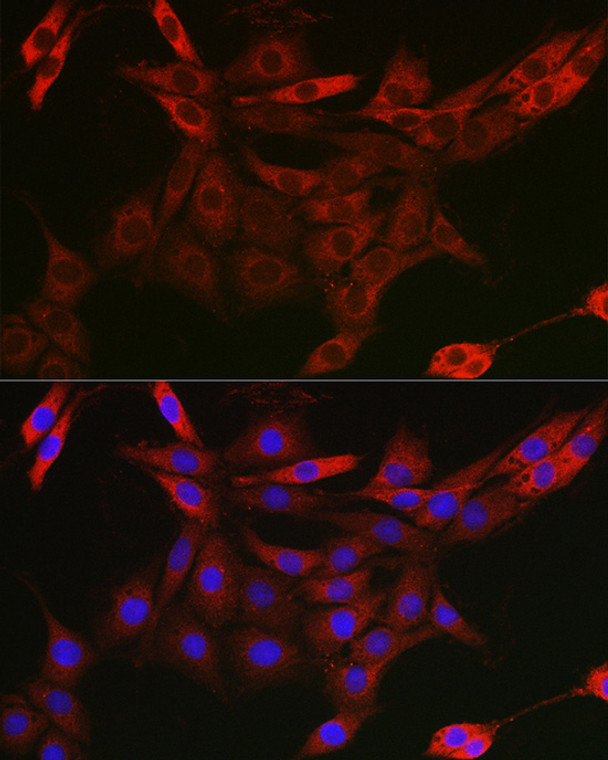| Host: |
Rabbit |
| Applications: |
WB/IHC/IF |
| Reactivity: |
Human/Mouse/Rat |
| Note: |
STRICTLY FOR FURTHER SCIENTIFIC RESEARCH USE ONLY (RUO). MUST NOT TO BE USED IN DIAGNOSTIC OR THERAPEUTIC APPLICATIONS. |
| Short Description: |
Rabbit polyclonal antibody anti-UBQLN4 (366-432) is suitable for use in Western Blot, Immunohistochemistry and Immunofluorescence research applications. |
| Clonality: |
Polyclonal |
| Conjugation: |
Unconjugated |
| Isotype: |
IgG |
| Formulation: |
PBS with 0.05% Proclin300, 50% Glycerol, pH7.3. |
| Purification: |
Affinity purification |
| Dilution Range: |
WB 1:500-1:1000IHC-P 1:50-1:200IF/ICC 1:50-1:200 |
| Storage Instruction: |
Store at-20°C for up to 1 year from the date of receipt, and avoid repeat freeze-thaw cycles. |
| Gene Symbol: |
UBQLN4 |
| Gene ID: |
56893 |
| Uniprot ID: |
UBQL4_HUMAN |
| Immunogen Region: |
366-432 |
| Immunogen: |
Recombinant fusion protein containing a sequence corresponding to amino acids 366-432 of human UBQLN4 (NP_064516.2). |
| Immunogen Sequence: |
FGINAASLGSGMFNSPEMQA LLQQISENPQLMQNVISAPY MRSMMQTLAQNPDFAAQMMV NVPLFAG |
| Tissue Specificity | Highly expressed in pancreas, kidney, skeletal muscle, heart and throughout the brain, and at lower levels in placenta, lung and liver. |
| Post Translational Modifications | Phosphorylated by ATM at Ser-318 in response to DNA damage, leading to localization in the nucleus and recruitment to sites of DNA damage. Ubiquitinated.this does not lead to proteasomal degradation. May undergo both 'Lys-48'- and 'Lys-63'-linked polyubiquitination. |
| Function | Regulator of protein degradation that mediates the proteasomal targeting of misfolded, mislocalized or accumulated proteins. Acts by binding polyubiquitin chains of target proteins via its UBA domain and by interacting with subunits of the proteasome via its ubiquitin-like domain. Key regulator of DNA repair that represses homologous recombination repair: in response to DNA damage, recruited to sites of DNA damage following phosphorylation by ATM and acts by binding and removing ubiquitinated MRE11 from damaged chromatin, leading to MRE11 degradation by the proteasome. MRE11 degradation prevents homologous recombination repair, redirecting double-strand break repair toward non-homologous end joining (NHEJ). Specifically recognizes and binds mislocalized transmembrane-containing proteins and targets them to proteasomal degradation. Collaborates with DESI1/POST in the export of ubiquitinated proteins from the nucleus to the cytoplasm. Also plays a role in the regulation of the proteasomal degradation of non-ubiquitinated GJA1. Acts as an adapter protein that recruits UBQLN1 to the autophagy machinery. Mediates the association of UBQLN1 with autophagosomes and the autophagy-related protein LC3 (MAP1LC3A/B/C) and may assist in the maturation of autophagosomes to autolysosomes by mediating autophagosome-lysosome fusion. |
| Protein Name | Ubiquilin-4Ataxin-1 Interacting Ubiquitin-Like ProteinA1upAtaxin-1 Ubiquitin-Like-Interacting Protein A1uConnexin43-Interacting Protein Of 75 KdaCip75 |
| Cellular Localisation | NucleusCytoplasmChromosomeEndoplasmic ReticulumPerinuclear RegionCytoplasmic VesicleAutophagosomeColocalizes With The ProteasomeBoth In Nucleus And CytoplasmExported From The Nucleus Following Interaction With Desi1/PostIn Response To Dna Damage And Phosphorylation At Ser-318 By AtmLocalizes To The Nucleus And Is Recruited To Sites Of Dna Damage |
| Alternative Antibody Names | Anti-Ubiquilin-4 antibodyAnti-Ataxin-1 Interacting Ubiquitin-Like Protein antibodyAnti-A1up antibodyAnti-Ataxin-1 Ubiquitin-Like-Interacting Protein A1u antibodyAnti-Connexin43-Interacting Protein Of 75 Kda antibodyAnti-Cip75 antibodyAnti-UBQLN4 antibodyAnti-C1orf6 antibodyAnti-CIP75 antibodyAnti-UBIN antibody |
Information sourced from Uniprot.org
12 months for antibodies. 6 months for ELISA Kits. Please see website T&Cs for further guidance












